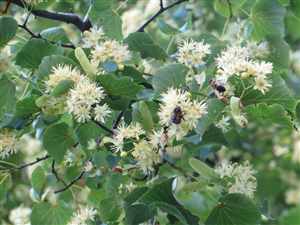Linden flower (Tilla spp.), Basswood, Limeblossom
Main Facts about Linden flower

Using Linden flower
Linden flowers are primarily used as a sedative for sleep disorders or anxiety, restlessness and nervousness. Flowers and young leaves are used in herbalism for colds, cough, fever, infections, inflammation, high blood pressure, headache, and as a diuretic, antispasmodic (reduces smooth muscle spasm along the digestive tract). They have been used internally as tea for treatment of disorders of the respiratory tract, fever and flu because this herb promotes sweating. The wood burned to charcoal is ingested to treat intestinal disorders and used externally against skin ulcerations. The double-flowered species are used to make perfumes.Linden flower is a remedy for: Cold and flu, Anxiety
Caution!
Patients with heart problems should not use this herb in large amounts or during prolonged periods of time. Consult your cardiologist.Cooking with Linden flower
The young leaves are very safe to eat. Don't eat the old bigger leaves, they aren't worth much and hard to digest. The flowers are also used for herbal teas and tinctures. Linden flowers make a fragrant, relaxing addition to herbal baths.How to grow Linden flower
It can grow in semi-shade (light woodland) or no shade. It prefers moist soil. The plant can tolerates strong winds but not maritime exposure. Woods on most fertile soils, especially limestone, it is commonly found on wooded limestone cliffs.| Licorice (Wild) |
Lobelia
|